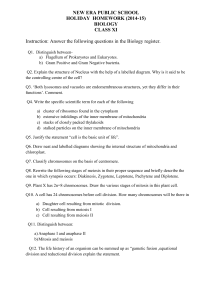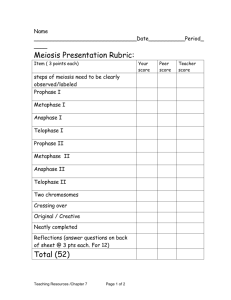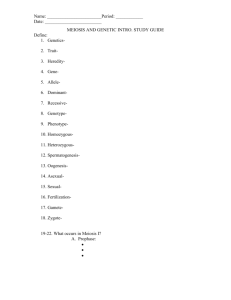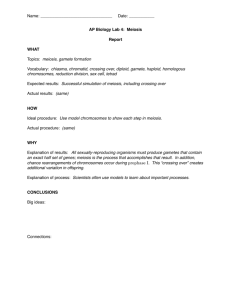Worksheet 4.2- Meiosis and non
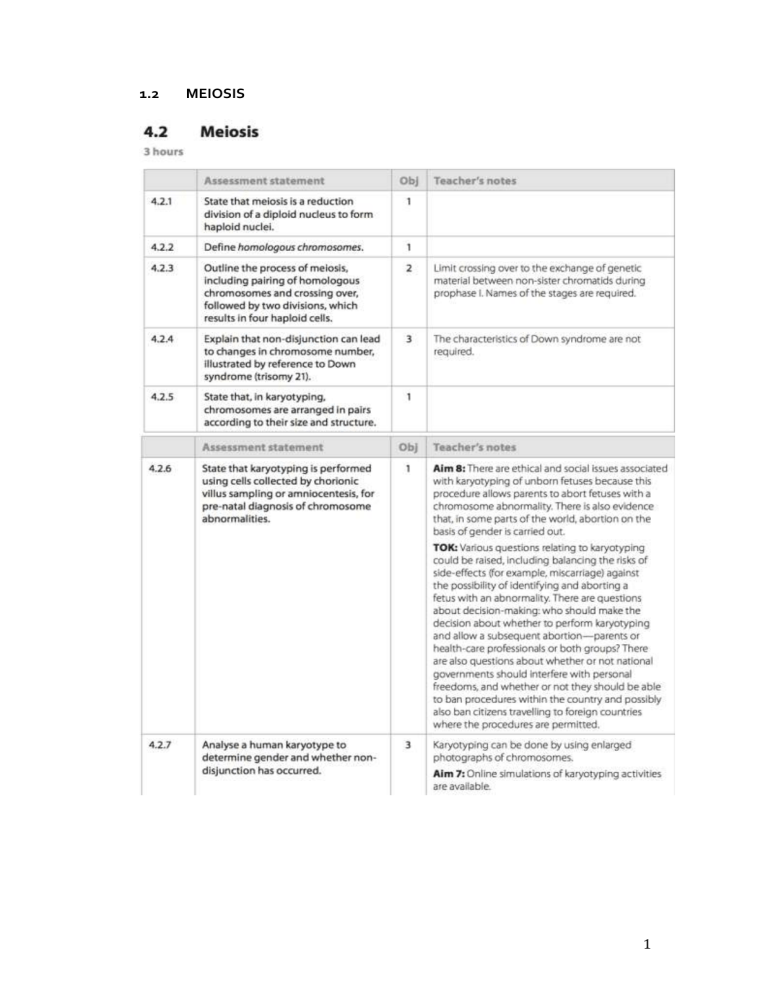
1.2
MEIOSIS
1
1.
DEFINITIONS:
Chromatids
Sister chromatids
Bivalents (Tetrads)
Synapsis
Crossing over and recombination
Chiasmata (chiasma)
2.
What are homologous chromosomes?
3.
What is a ‘reduction division’?
4.
Watch this simple run-through of meiosis: http://www.youtube.com/watch?v=kVMb4Js99tA - at=158
What is the point of meiosis?
2
5.
Complete the Hartnell College tutorial about meiosis: http://www.hartnell.edu/tutorials/biology/meiosis.html
6.
Key events of meiosis (draw and write!)
Meiosis I
Interphase
Prophase I
Metaphase I
Anaphase I
3
Telophase I
Cytokinesis
Meiosis II
Interphase
Prophase II
Metaphase II
Anaphase II
Telophase II
Cytokinesis
7.
Compare meiosis and mitosis:
DNA replication
Number of divisions
Mitosis
Synapsis
Number of daughter cells
Genetic composition of daughter cells
Meiosis
4
Functions
8. Practice questions on diploid/haploid/chromosome numbers: a): A cell with a diploid number of 12 chromosomes undergoes meiosis. How many daughter cells will be produced and how many chromosomes in each? b): A gamete contains 18 chromosomes. How many chromosomes in the somatic cell? c): A diploid cell contains 16 chromosomes. How many chromatids are present in metaphase I?
HL Topic 10.1.3: The role of meiosis in genetic variation
9. Describe what is happening in this image. During which phase of meiosis does this occur?
5
10. Explain how random orientation in metaphase II leads to further genetic variation. State the number if possible genetic combinations in human cells.
11. Outline how sexual reproduction leads to even further genetic variation within a species
6
SL AND HL: NON-DISJUNCTION DISORDERS
12. Explain how non-disjunction and fertilization lead to aneuploidies such as trisomy
13. Distinguish between non-disjunction and trisomy
14. Compare the outcome of non-disjunction, as it occurs in in anaphase I, with nondisjunction as it occurs in anaphase II:
Anaphase I Anaphase II
Number of normal cells
Cells with extra chromosome (N+1)
Cells lacking a chromosome (N – 1)
7
15. Using the graph below, outline the effect of maternal age on the prevalence of
Down’s Syndrome
16. Explain the effects of Down’s Syndrome
8
17. A karyotype can be obtained by amniocentesis (or recently, alternative methods) in order to test for non-disjunction and other genetic disorders. Outline how the cells are retrieved using:
1.
Amniocentesis
2.
Chorionic Villus sampling
21. Name two alternatives to amniocentesis, and their advantages/disadvantages compared with invasive screening techniques (VCS and amniocentesis) iii) i) ii)
18. State 3 visual aspects of chromosomes, which can be used for karyotyping:
9
19. Karyotyping practice:
Complete and submit (electronically) the following tutorial on Karyotyping: http://www.biologycorner.com/karyotype/
Use this link from Utah Genetics to review non-disjunction and trisomies
10
11
